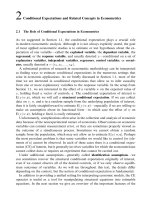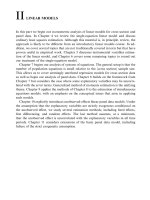Book Econometric Analysis of Cross Section and Panel Data By Wooldridge - Chapter 1 pot
Bạn đang xem bản rút gọn của tài liệu. Xem và tải ngay bản đầy đủ của tài liệu tại đây (87.22 KB, 10 trang )
I INTRODUCTION AND BACKGROUND
In this part we introduce the basic approach to econometrics taken throughout the
book and cover some background material that is important to master before reading
the remainder of the text. Students who have a solid understanding of the algebra of
conditional expectations, conditional variances, and linear projections could skip
Chapter 2, referring to it only as needed. Chapter 3 contains a summary of the
asymptotic analysis needed to read Part II and beyond. In Part III we introduce ad-
ditional asymptotic tools that are needed to study nonlinear estimation.
1Introduction
1.1 Causal Relationships and Ceteris Par ibus Analysis
The goal of most empirical studies in economics and other social sciences is to de-
termine whether a change in one variable, say w, causes a change in another variable,
say y. For example, does having another year of education cause an increase in
monthly salary? Does reducing class size cause an improvement in student per-
formance? Does lowering the business property tax rate cause an increase in city
economic activity? Because economic variables are properly interpreted as random
variables, we should use ideas from probability to formalize the sense in which a
change in w causes a change in y.
The notion of ceteris paribus—that is, holding all other (relevant) factors fixed—is
at the crux of establishing a causal relationship. Simply finding that two variables
are correlated is rarely enough to conclude that a change in one variable causes a
change in another. This result is due to the nature of economic data: rarely can we
run a controlled experiment that allows a simple correlation analysis to uncover
causality. Instead, we can use econometric methods to e¤ectively hold other factors
fixed.
If we focus on the average, or expected, response, a ceteris paribus analysis entails
estimating Eðy jw; cÞ, the expected value of y conditional on w and c. The vector c—
whose dimension is not important for this discussion—denotes a set of control vari-
ables that we would like to explicitly hold fixed when studying the e¤ect of w on the
expected value of y. The reason we control for these variables is that we think w is
correlated with other factors that also influence y.Ifw is continuous, interest centers
on qEðy jw; cÞ=qw, which is usually called the partial e¤ect of w on Eðy jw; cÞ.Ifw is
discrete, we are interested in Eðy jw; cÞ evaluated at di¤erent values of w, with the
elements of c fixed at the same specified values.
Deciding on the list of proper controls is not always straightforward, and using
di¤erent controls can lead to di¤erent conclusions about a causal relationship be-
tween y and w. This is where establishing causality gets tricky: it is up to us to decide
which factors need to be held fixed. If we settle on a list of controls, and if all ele-
ments of c can be observed, then estimating the partial e¤ect of w on Eðy jw; cÞ is
relatively straightforward. Unfortunately, in economics and other social sciences,
many elements of c are not observed. For example, in estimati ng the causal e¤ect of
education on wage, we might focus on Eðwage jeduc; exper; abilÞ where educ is years
of schooling, exper is years of workforce experience, and abil is innate ability. In this
case, c ¼ðexper; abil Þ, where exper is observed but abil is not. (It is widely agreed
among labor economists that experience and ability are two factors we should hold
fixed to obtain the causal e¤ec t of education on wages. Other factors, suc h as years
with the current employer, might belong as well. We can all agree that something
such as the last digit of one’s social security number need not be included as a con-
trol, as it has nothing to do with wage or education.)
As a second example, consider establishing a causal relationship between student
attendance and performance on a final exam in a principles of economics class. We
might be interested in Eðscore jattend; SAT; priGPAÞ, where score is the final exam
score, attend is the attendance rate, SAT is score on the scholastic aptitude test, and
priGPA is grade point average at the beginning of the term. We can reasonably col-
lect data on all of these variables for a large group of students. Is this setup enough
to decide whether attendance has a causal e¤ect on performance? Maybe not. While
SAT and priGPA are general measures reflecting student ability and study habits,
they do not neces sarily measure one’s interest in or aptitude for econonomics. Such
attributes, which are di‰cult to quantify, may nevertheless belong in the list of con-
trols if we are going to be able to infer that attendance rate has a causal e¤ect on
performance.
In addition to not being able to obtain data on all desired controls, other problems
can interfere with estimating causal relationships. For example, even if we have good
measures of the elements of c, we might not have very good measures of y or w.A
more subtle problem—which we study in detail in Chapter 9—is that we may only
observe equilibrium values of y and w when these variables are simultaneously de-
termined. An example is determining the caus al e¤ect of conviction rates ðwÞ on city
crime rates ðyÞ.
A first course in econometrics teaches students how to apply multiple regression
analysis to estimate ceteris paribus e¤ects of explanatory variables on a response
variable. In the rest of this book, we will study how to estimate such e¤ec ts in a
variety of situations. Unlike most introductory treatments, we rely heavily on con-
ditional expectations. In Chapter 2 we provide a deta iled summary of properties of
conditional expectations.
1.2 The Stochastic Setting and Asymptotic Analysis
1.2.1 Data Structures
In order to give proper treatment to modern cross section and panel data methods,
we must choose a stochastic setting that is appropriate for the kinds of cross section
and panel data sets collected for most econometric applications. Naturally, all else
equal, it is best if the setting is as simple as possible. It should allow us to focus on
Chapter 14
interpreting assumptions with economic content while not having to worry too much
about technical regularity conditions. (Regularity conditions are assumptions in-
volving things such as the number of absolute moments of a random variable that
must be finite.)
For much of this book we adopt a random sampling assumption. More precisely,
we assume that (1) a population model has been specified and (2) an independent,
identically distributed (i.i.d.) sample can be drawn from the population. Specifying a
population model—which may be a model of Eðy jw; cÞ, as in Section 1.1—requires
us first to clearly define the population of interest. Defining the relevant population
may seem to be an obvious requirement. Nevertheless, as we will see in later chapters,
it can be subtle in some cases.
An important virtue of the random sampling assumption is that it allows us to
separate the sampling assumption from the assumptions made on the population
model. In addition to putting the proper emphasis on assumptions that impinge on
economic behav ior, stating all assumptions in terms of the population is actually
much easier than the traditional approach of stating assumptions in terms of full data
matrices.
Because we will rely heavily on random sampling, it is impo rtant to know what it
allows and what it rules out. Random sampling is often reasonable for cross section
data, where, at a given point in time, units are selected at random from the popula-
tion. In this setup, any explanatory variables are treated as random outcomes along
with data on response variables. Fixed regressors cannot be identically distributed
across observations, and so the random sampling assumption technically excludes the
classical linear model. This result is actually desirable for our purposes. In Section 1.4
we provide a brief discussion of why it is important to treat explanatory variables as
random for modern econometric analysis.
We should not confuse the random sampling assumption with so-called experi-
mental data. Experimental data fall under the fixed explanatory variables paradigm.
With experimental data, researchers set values of the explanatory variables and then
observe values of the response variable. Unfortunately, true experiments are quite
rare in economics, and in any case nothing practically important is lost by treating
explanatory variables that are set ahead of time as being random. It is safe to say that
no one ever went astray by assuming random sampli ng in place of independent
sampling with fixed explanatory variables.
Random sampling does exclude cases of some interest for cross section analysis.
For example, the identical distribution assumption is unlikely to hold for a pooled
cross section, where random samples are obtained from the population at di¤erent
Introduction 5
points in time. This case is covered by independent, not identically distributed (i.n.i.d.)
observations. Allowing for non-identically distributed observations under indepen-
dent sampling is not di‰cult, and its practical e¤ects are easy to deal with. We will
mention this case at several points in the book after the analyis is done under random
sampling. We do not cover the i.n.i.d. case explicitly in derivations because little is to
be gained from the additional complication.
A situation that does require special consideration occurs when cross section ob-
servations are not independent of one another. An example is spatial correlation
models. This situation arises when dealing with large geographical units that cannot
be assumed to be independent draws from a large population, such as the 50 states in
the United States. It is reasonable to expect that the unemployment rate in one state
is correlated with the unemployment rate in neighboring states. While standard esti-
mation methods—such as ordinary least squares and two-stage least squares—can
usually be applied in these cases, the asymptotic theory needs to be altered. Key sta-
tistics often (although not always) need to be modified. We will briefly discuss some
of the issues that arise in this case for single-equation linear models, but otherwise
this subject is beyond the scope of this book. For better or worse, spatial correlation
is often ignored in applied work because correcting the problem can be di‰cult.
Cluster sampling also induces correlation in a cross section data set, but in most
cases it is relatively easy to deal with econometrically. For example, retirement saving
of employees within a firm may be correlated because of common (often unobserved)
characteristics of workers within a firm or because of features of the firm itself (such
as type of retirement plan). Each firm represents a group or cluster, and we may
sample several workers from a large number of firms. As we will see later, provided
the number of clusters is large relative to the cluster sizes, standard methods can
correct for the presence of within-cluster correlation.
Another important issue is that cross section samples often are, either intentionally
or unintentionally, chosen so that they are not random samples from the population
of interest. In Chapter 17 we discuss such problems at length, including sample
selection and stratified sampling. As we will see, even in cases of nonrandom samples,
the assumptions on the population model play a central role.
For panel data (or longitudinal data), which consist of repeated observations on the
same cross section of, say, individuals, households, firms, or cities, over time, the
random sampling assumption initially appears much too restrictive. After all, any
reasonable stochastic setting should allow for correlation in individual or firm be-
havior over time. But the random sampling assumption, properly stated, does allow
for temporal correlation. What we will do is assume random sampling in the cross
Chapter 16
section dimension. The dependence in the time series dimension can be entirely un-
restricted. As we will see, this approach is justified in panel data applications with
many cross section observations spanning a relatively short time period. We will
also be able to cover panel data sample selection and stratification issues within this
paradigm.
A panel data setup that we will not adequately cover—although the estimation
methods we cover can be usually used—is seen when the cross section dimension and
time series dimensions are roughly of the same magnitude, such as when the sample
consists of countries over the post–World War II period. In this case it makes little
sense to fix the time series dimension and let the cross section dimension grow. The
research on asymptotic analysis with these kinds of panel data sets is still in its early
stages, and it requires special limit theory. See, for example, Quah (1994), Pesaran
and Smith (1995), Kao (1999), and Phillips and Moon (1999).
1.2.2 Asymptotic Analysis
Throughout this book we focus on asymptotic properties, as opposed to finite sample
properties, of estimators. The primary reason for this emphasis is that finite sample
properties are intractable for most of the estimators we study in this book. In fact,
most of the estimators we cover will not have desirable finite sample properties such
as unbiasedness. Asymptotic analysis allows for a unified treatment of estimation
procedures, and it (along with the random sampling assumption) allows us to state all
assumptions in terms of the underlying population. Naturally, asymptotic analysis is
not without its drawbacks. Occasionally, we will mention when asymptotics can lead
one astray. In those cases where finite sample properties can be derived, you are
sometimes asked to derive such properties in the problems.
In cross section analysis the asymptotics is as the number of observations, denoted
N throughout this book, tends to infinity. Usually what is meant by this statement is
obvious. For panel data analysis, the asymptotics is as the cross section dimension
gets large while the time series dimension is fixed.
1.3 Some Examples
In this section we provide two examples to emphasize some of the concepts from the
previous sections. We begin with a standard example from labor economics.
Example 1.1 (Wage O¤er Function): Suppose that the natural log of the wage o¤er,
wage
o
, is determined as
Introduction 7
logðwage
o
Þ¼b
0
þ b
1
educ þb
2
exper þb
3
married þu ð1:1Þ
where educ is years of schooling, exper is years of labor market experience, and
married is a binary variable indicating marital status. The variable u, called the error
term or disturbance, contains unobserved factors that a¤ec t the wage o¤er. Interest
lies in the unknown parameters, the b
j
.
We should have a concrete population in mind when specifying equation (1.1). For
example, equation (1.1) could be for the population of all working women. In this
case, it wi ll not be di‰cult to obtain a random sample from the population.
All assumptions can be stated in terms of the population model. The crucial
assumptions involve the relationship between u and the observable explanatory vari-
ables, educ, exper, and married. For example, is the expected value of u given the
explanatory variables educ , exper, and married equal to zero? Is the variance of u
conditional on the explanatory variables constant? There are reasons to think the
answer to both of these questions is no, something we discuss at some length in
Chapters 4 and 5. The point of raising them here is to emphasize that all such ques-
tions are most easily c ouched in terms of the population model.
What happens if the relevant population is all women over age 18? A problem
arises because a random sample from this population will include women for whom
the wage o¤er cannot be observed because they are not working. Nevertheless, we
can think of a random sample being obtained, but then wage
o
is unobserved for
women not working.
For deriving the properties of estimators, it is often useful to write the population
model for a generic draw from the population. Equation (1.1) becomes
logðwage
o
i
Þ¼b
0
þ b
1
educ
i
þ b
2
exper
i
þ b
3
married
i
þ u
i
; ð1:2Þ
where i indexes person. Stating assumptions in terms of u
i
and x
i
1 ðeduc
i
; exper
i
;
married
i
Þ is the same as stating assumptions in terms of u and x. Throughout this
book, the i subscript is reserved for indexing cross section units, such as individual,
firm, city, and so on. Letters such as j, g, and h will be used to index variables,
parameters, and equations.
Before ending this example, we note that using matrix notation to write equation
(1.2) for all N observations adds nothing to our understanding of the model or sam-
pling scheme; in fact, it just gets in the way because it gives the mistaken impression
that the matrices tell us something about the assumptions in the underlying popula-
tion. It is much better to focus on the population model (1.1).
The next example is illustrative of panel data applications.
Chapter 18
Example 1.2 (E¤ect of Spillovers on Firm Output): Suppose that the population is
all manufacturing firms in a country operating during a given three-year period. A
production function describing output in the population of firms is
logðoutput
t
Þ¼d
t
þ b
1
logðlabor
t
Þþb
2
logðcapital
t
Þ
þ b
3
spillover
t
þ quality þ u
t
; t ¼ 1; 2; 3 ð1:3Þ
Here, spillover
t
is a measure of foreign firm concentration in the region containing the
firm. The term quality contains unobserved factors—such as unobserved managerial
or worker quality—which a¤ect productivity and are constant over time. The error u
t
represents unobserved shocks in each time period. The presence of the parameters d
t
,
which represent di¤erent intercepts in each year, allows for aggregate productivity
to change over time. The coe‰cients on labor
t
, capital
t
, and spillover
t
are assumed
constant across years.
As we will see when we study panel data methods, there are several issues in
deciding how best to estimate the b
j
. An important one is whether the unobserved
productivity factors (quality) are correlated with the observable inputs. Also, can we
assume that spillover
t
at, say, t ¼ 3 is uncorrelated with the error terms in all time
periods?
For panel data it is especially useful to add an i subscript indicating a generic cross
section observation—in this case, a randomly sampled firm:
logðoutput
it
Þ¼d
t
þ b
1
logðlabor
it
Þþb
2
logðcapital
it
Þ
þ b
3
spillover
it
þ quality
i
þ u
it
; t ¼ 1; 2; 3 ð1:4Þ
Equation (1.4) makes it clear that quality
i
is a firm-specific term that is constant over
time and also has the same e¤ect in each time period, while u
it
changes across time
and firm. Nevertheless, the key issues that we must address for estimation can be
discussed for a generic i, since the draws are assumed to be randomly made from the
population of all manufacturing firms.
Equation (1.4) is an example of another convention we use throughout the book: the
subscript t is reserved to index time, just as i is reserved for indexing the cross section.
1.4 Why Not Fixed Explanatory Variables?
We have seen two examples where, generally speaking, the error in an equation can
be correlated with one or more of the explanatory variables. This possibility is
Introduction 9
so prevalent in social science applications that it makes little sense to adopt an
assumption—namely, the assumption of fixed explanatory variables—that rules out
such correlation a priori.
In a first course in econometrics, the method of ordinary least squares (OLS) and
its extensions are usually learned under the fixed regressor assumption. This is ap-
propriate for understanding the mechanics of least squares and for gaining experience
with statistical derivations. Unfortunately, reliance on fixed regressors or, more gen-
erally, fixed ‘‘exogenous’’ variables, can have unintended consequences, especially in
more advanced settings. For example, in Chapters 7, 10, and 11 we will see that as-
suming fixed regressors or fixed instrumental variables in panel data models imposes
often unrealistic restrictions on dynamic economic behavior. This is not just a tech-
nical point: estimation methods that are consistent under the fixed regressor as-
sumption, such as generalized least squares, are no longer consistent when the fixed
regressor assumption is relaxed in interesting ways.
To illustrate the shortcomings of the fixed regressor assumption in a familiar con-
text, consider a linear model for cross section data, written for each observation i as
y
i
¼ b
0
þ x
i
b þ u
i
; i ¼ 1; 2; ; N
where x
i
is a 1 ÂK vector and b is a K Â1 vector. It is common to see the ‘‘ideal’’
assumptions for this model stated as ‘‘The errors fu
i
: i ¼ 1; 2; ; Ng are i.i.d. with
Eðu
i
Þ¼0 and Varðu
i
Þ¼s
2
.’’ (Sometimes the u
i
are also assumed to be normally
distributed.) The problem with this statement is that it omits the most important
consideration: What is assumed about the relationship between u
i
and x
i
? If the x
i
are
taken as nonrandom—whic h, evidently, is very often the implicit a ssumption—then
u
i
and x
i
are independent of one another. In nonexperimental environments this as-
sumption rules out too many situations of interest. Some important questions, such
as e‰ciency comparisons across models with di¤erent exp lanatory variables, cannot
even be asked in the context of fixed regressors. (See Problems 4.5 and 4.15 of
Chapter 4 for specific examples.)
In a random sampling context, the u
i
are always independent and identically dis-
tributed, regardless of how they are related to the x
i
. Assuming that the population
mean of the error is zero is without loss of generality when an intercept is included
in the model. Thus, the statement ‘‘The errors fu
i
: i ¼ 1; 2; ; Ng are i.i.d. with
Eðu
i
Þ¼0 and Varðu
i
Þ¼s
2
’’ is vacuous in a random sampling context. Viewing the
x
i
as random draws along with y
i
forces us to think about the relationship between
the error and the explanatory variables in the population. For example, in the popu-
lation model y ¼ b
0
þ xb þ u, is the expected value of u given x equal to zero? Is u
correlated with one or more elements of x? Is the variance of u given x constant, or
Chapter 110
does it depend on x? These are the assumptions that are relevant for estimating b and
for determining how to perform statistical inference.
Because our focus is on asymptotic analysis, we have the luxury of allowing for
random explanatory variables throughout the book, whether the setting is linear
models, nonlinear models, single-equation analysis, or system analysis. An incidental
but nontrivial benefit is that, compared with frameworks that assume fixed explan-
atory variab les, the unifying theme of random sampling actually simplifies the
asymptotic analysis. We will never state assumptions in terms of full data matrices,
because such assumptions can be imprecise and can impose unintended restrictions
on the population model.
Introduction 11









